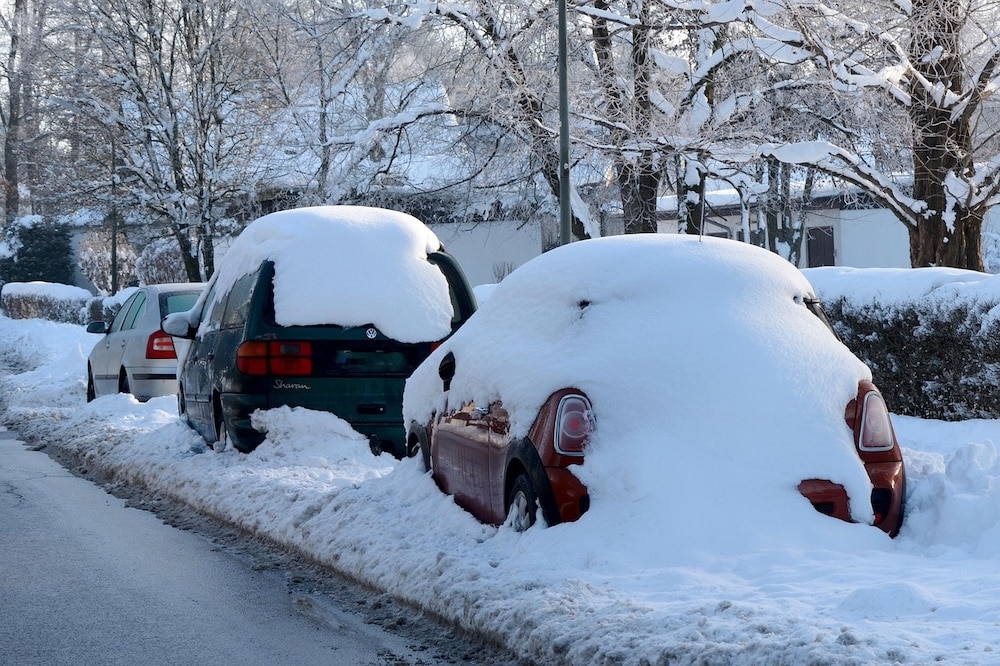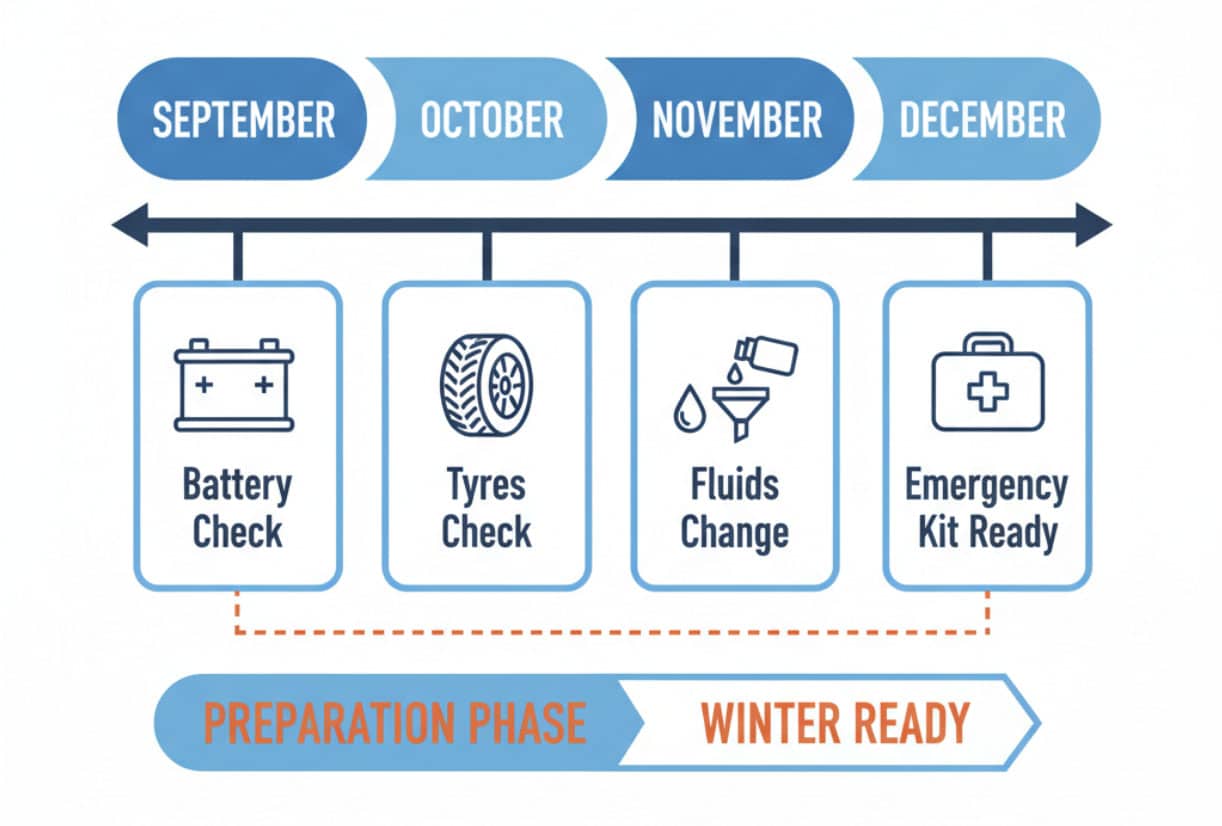
As temperatures drop across the UK, preparing your vehicle for winter becomes essential for both safety and reliability. Cold weather puts extra strain on your car’s components, and proper preparation can prevent breakdowns during the chilly months ahead. Taking action now will save you from unexpected problems when frost and freezing conditions arrive.
The most critical steps involve checking your battery, tyres, fluids, and visibility systems. A well-prepared car not only starts reliably on cold mornings but also keeps you safe on wet and potentially icy roads. According to Green Flag, over 1.2 million breakdowns are expected on Britain’s roads between November 2024 and January 2025 – equivalent to more than nine breakdowns every minute. Don’t get caught out in the cold, peak car breakdown season is here – Direct Line Group. Many drivers overlook simple maintenance tasks, yet they make the difference between smooth winter driving and roadside emergencies.
Essential fluid checks and changes
AUTODOC states that changing the engine oil before winter arrives helps protect your engine during cold starts. Cold temperatures make oil thicker, which means your engine works harder to circulate it. Fresh oil flows better in low temperatures, reducing wear on engine components during those crucial first moments after starting.
Your coolant system needs particular attention before winter. The antifreeze mixture should protect down to at least -15°C, though many UK regions benefit from protection to -25°C during severe cold snaps. A proper coolant mixture prevents freezing that could crack your engine block or damage the radiator – repairs that typically cost hundreds or even thousands of pounds.
Screen wash deserves special mention too. Standard summer screen wash freezes in cold weather, leaving you unable to clean your windscreen when you need it most. Winter-grade screen wash remains liquid at sub-zero temperatures and contains additives that help remove road salt and grime more effectively.
Battery and electrical system preparation
Flat batteries are the top reason for winter breakdowns, accounting for over 440,000 (35%) of all call-outs in winter. Call-outs for flat batteries increase by 60% over the colder winter months compared to May, June, and July. Don’t get caught out in the cold, peak car breakdown season is here – Direct Line Group. Car batteries lose significant power in cold weather – a battery that works perfectly in summer might struggle when temperatures approach freezing. Most batteries last between three to five years, and those approaching this age often fail during the first cold spell of winter.
Winter preparation timeline

This timeline shows the optimal sequence for winter car preparation. Starting in September allows you to address any issues before the cold weather arrives. The progression from battery checks to emergency kit preparation follows a logical order – beginning with components most likely to fail suddenly (battery) and ending with precautionary measures (emergency kit). By spreading these tasks across autumn months, you avoid the rush and potential part shortages that occur when everyone prepares simultaneously in late November.
Testing your battery takes just minutes at most garages or auto parts shops. They’ll check both the battery’s charge level and its ability to hold that charge. If your car already struggles to start on cool mornings, replacing the battery before winter arrives prevents those frustrating moments when you’re running late and your car won’t start.
Clean battery terminals also matter more in winter. Corrosion creates resistance that further reduces the battery’s effectiveness. A simple wire brush and some petroleum jelly protect terminals from moisture and maintain good electrical connections throughout winter.
Tyre safety for winter roads
Your tyres represent the only contact between your car and the road, making them crucial for winter safety. The legal minimum tread depth stands at 1.6mm, but many safety organisations recommend at least 3mm for winter driving. Greater tread depth channels water away more effectively, reducing the risk of aquaplaning on wet roads.
Winter maintenance costs comparison
| Service Item | DIY Cost Range | Garage Cost Range | Potential Saving |
| Oil Change | £25-40 | £60-120 | £35-80 |
| Battery Replacement | £50-100 | £80-150 | £30-50 |
| Wiper Rubber Refills | £6-16 (pair) | £30-60 (full blades) | £24-44 |
| Coolant Top-up | £10-15 | £40-60 | £30-45 |
| Screen Wash (5L) | £5-10 | £15-25 | £10-15 |
| Total Winter Prep | £96-181 | £225-415 | £129-234 |
These figures demonstrate significant savings available through DIY maintenance. The most substantial savings come from oil changes, where garage costs of £60-120 include labour charges that account for roughly half the total price. Wiper rubber refills show particularly good value – at £6-16 per pair for refills versus £30-60 for complete blade replacements at garages, you save £24-44 whilst achieving the same result. Even basic tasks like topping up screen wash can save £10-15, and these small amounts add up quickly. The total potential saving of £129-234 represents money better spent on quality winter tyres or emergency equipment.
Tyre pressure drops in cold weather – approximately 1-2 PSI for every 10°C temperature decrease. Regular pressure checks ensure optimal grip and prevent uneven wear. Under-inflated tyres reduce fuel economy and compromise handling, particularly dangerous on slippery winter roads.
Consider whether winter tyres suit your driving needs. While not mandatory in the UK, winter tyres provide better grip below 7°C, even on dry roads. Their special rubber compound remains flexible in cold conditions, and deeper tread patterns handle standing water more effectively than standard tyres.
Visibility and wiper maintenance
Replacing just the blade rubber instead of the entire blade assembly makes perfect financial and environmental sense. While new wiper blades can cost £15-40 per blade, wiper refills typically cost £3-8 each. The metal frame and wiper arm remain in good condition for years, so there’s no need to throw away perfectly functional components. Over time, wiper rubbers experience wear, which can lead to tears and cause the blades to leave streaks on the windscreen. These issues reduce visibility and compromise safety, making timely replacement essential.
Check all lights function correctly, including indicators, brake lights, and fog lights. Winter brings shorter days and poorer visibility, making proper lighting vital for safety. Keep spare bulbs in your car – police can fine you for defective lights, and changing them yourself saves garage fees.
Winter emergency kit essentials
Prepare an emergency kit containing jump leads, torch, warm clothing, blanket, phone charger, de-icer, scraper, and some snacks and water. These items prove invaluable during breakdowns or unexpected delays. Many drivers find themselves unprepared when problems occur, turning minor inconveniences into genuine emergencies.
AUTODOC recommends keeping essential fluids topped up and carrying spare supplies where practical, ensuring you’re never caught short during winter journeys.
Sources of information used in the article
- Green Flag
- Direct Line Group
- AUTODOC
FAQ: Preparing your car for winter
- Why do batteries fail more often in winter and how can this be avoided?
Batteries lose a significant amount of power in cold weather – a battery that works perfectly in summer may struggle to start the engine at temperatures close to zero. Dead batteries are the main cause of winter breakdowns, accounting for 35% of all calls. Most batteries last three to five years, and those approaching this age often fail during the first cold spells of winter.
Prevention: Have your battery tested at a car service centre or auto parts store, clean the terminals of corrosion, and replace the battery if it is already struggling to start the car in the cool morning hours.
- What fluids should be checked and replaced before winter?
Engine oil: Changing the oil before winter protects the engine during cold starts. Cold temperatures make the oil thicker, forcing the engine to work harder to circulate it.
Coolant: The antifreeze mixture should protect down to at least -15°C, although in many parts of the UK it is better to have protection down to -25°C. The correct coolant mixture prevents freezing, which can lead to cracks in the engine block.
Winter windscreen washer fluid: Standard summer fluid freezes in cold weather. Winter fluid remains liquid at sub-zero temperatures and is more effective at removing road salt and dirt.
- What is the minimum tyre tread depth recommended for safe winter driving?
Although the legal minimum is 1.6 mm, many safety organisations recommend at least 3 mm for winter driving. Greater tread depth drains water more effectively, reducing the risk of aquaplaning on wet roads. It is also important to remember that tyre pressure drops in cold weather – by approximately 1-2 PSI for every 10°C drop in temperature.
- Should you replace the entire windscreen wiper blades or is it sufficient to replace only the rubber?
Replacing only the rubber elements is a more economical and environmentally friendly choice. While new blades can cost £15-40 each, rubber inserts usually cost £3-8 each. The metal frame and wiper arm remain in good condition for years, so there is no need to throw away perfectly functional components. This can save you £24-44 on a pair of blades.
- What should be included in a winter emergency kit for your car?
Prepare an emergency kit containing:
- Jumper cables
- Flashlight
- Warm clothing and a blanket
- A phone charger
- De-icer and ice scraper
- Snacks and water
These items will prove invaluable during breakdowns or unexpected delays. Many drivers find themselves unprepared when problems arise, turning minor inconveniences into real emergencies.






